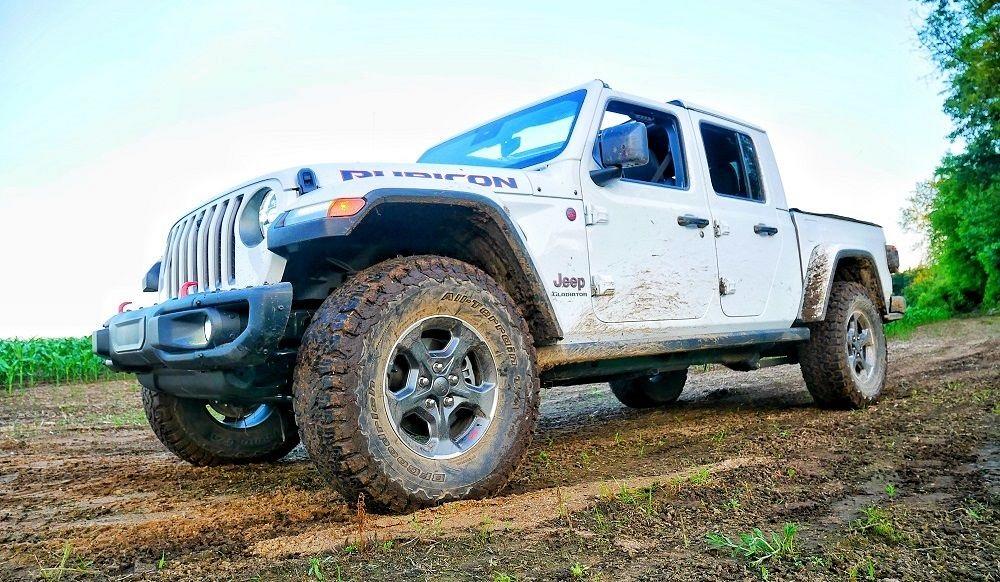Owner, Brown Dog Welding
- FMA
- The Fabricator
- FABTECH
- Canadian Metalworking
Categories
- Additive Manufacturing
- Aluminum Welding
- Arc Welding
- Assembly and Joining
- Automation and Robotics
- Bending and Forming
- Consumables
- Cutting and Weld Prep
- Electric Vehicles
- En Español
- Finishing
- Hydroforming
- Laser Cutting
- Laser Welding
- Machining
- Manufacturing Software
- Materials Handling
- Metals/Materials
- Oxyfuel Cutting
- Plasma Cutting
- Power Tools
- Punching and Other Holemaking
- Roll Forming
- Safety
- Sawing
- Shearing
- Shop Management
- Testing and Measuring
- Tube and Pipe Fabrication
- Tube and Pipe Production
- Waterjet Cutting
Industry Directory
Webcasts
Podcasts
FAB 40
Advertise
Subscribe
Account Login
Search
A truck fit for a metal fabricator
Jeep’s Gladiator Rubicon isn’t just a Wrangler with a small bed on the back
- By Josh Welton
- August 6, 2019

Jeep’s Gladiator Rubicon truck is a heavy-duty vehicle that a metal fabricator can appreciate. Photo provided by Josh and Darla Welton
In an age of plastic bumpers, bedazzled wheels, and other bits of faux off-road virtue signaling, the Jeep Gladiator Rubicon is breath of fresh, argon-tinged air.
It looks and feels substantial, more “fabricated” than merely assembled. With a high-strength yet lightweight steel frame, aluminum body, sturdy metal bumpers, heavy-duty skid plates, and rock sliders throughout, the Gladiator Rubicon deflects and dishes out much harsher punishments than it receives. It’s industrial grade in a very real, very tactile manner.
It might have a truck bed, but it’s a legit Jeep.
The Gladiator Rubicon has thick-wall Dana 44 front and rear axles along with electric Tru-Lok diffs, removable doors and top, a fold-down windshield, a disconnecting front sway bar, and a Rock-Trac t-case. Approach angle, ground clearance, and crawl ratio are each the best in class. The Gladiator will get you into and out of places that give other 4x4s unhealthy fits of jealousy.
And yet it’s still a legit truck, it’s not just a Wrangler with a small bed bolted on the back like I first thought. The Gladiator utilizes a longer frame than its Jeep brother; it has its own ladder design, which allows for a Ram-esque suspension. Given the Ram’s smooth ride and proven performance, this makes all the sense in the world.
As a matter of fact, while the geometry is a bit different, the Gladiator shares both rear control arms and a track bar with Ram’s DS (“Classic”) platform. More room in the truck’s rear also allows for forward-facing, aluminum-bodied Fox shocks, which is a stronger orientation than the space-limited Wrangler’s rear facing shocks. This is one of the reasons the Gladiator, at 7,000-plus lbs., has double the Wrangler’s tow rating.
The increased tow rating also requires more engine cooling, which results in one of the more subtle differences between the Wrangler and the Gladiator. I knew something wasn’t quite the same in the proportions, that for some reason the truck version looks slightly more aggressive, but I could never quite put my finger on why.
It turns out that, to increase airflow into the engine bay to keep it cool under strain, Jeep engineers widened the openings in the brand’s iconic seven-slot grill ever so slightly. The effect from an aesthetic viewpoint is that the vehicle looks just a little lower and wider, even though it’s not.
The bed is deceptively capable too. The ability to haul a pair of dirt bikes, kayaks, or 11 sheets of ¾-in.-thick 4x8 sheets of plywood was one of the tasks Jeep designed the steel bed around. This makes the Gladiator equally as adept at home improvement supply runs or gear transport as for outdoor fun and games.
Or, if you’re more into welding than carpentry and white-water rafting, the Gladiator Rubicon’s 1,200-lb. payload and 40-in. by 60-in. inside dimensions are more than fit for hauling around a Miller Bobcat Airpak 200, welding accessories, a couple of medium to large gas bottles, and tools.
In addition, there’s LED lighting and a 115-V/400-W outlet in the bed, as well as a rugged Bluetooth speaker that detaches from behind the rear seat. Whether you’re on a job site or camping by a river, this vehicle has you covered! And all this is before you use the Gladiator’s impressive towing ability.
The Jeep Gladiator is also built in Midwest America, in Toledo, just like the Wrangler. An American icon, built in America.
subscribe now

The Fabricator is North America's leading magazine for the metal forming and fabricating industry. The magazine delivers the news, technical articles, and case histories that enable fabricators to do their jobs more efficiently. The Fabricator has served the industry since 1970.
start your free subscriptionAbout the Author

- Stay connected from anywhere

Easily access valuable industry resources now with full access to the digital edition of The Fabricator.

Easily access valuable industry resources now with full access to the digital edition of The Welder.

Easily access valuable industry resources now with full access to the digital edition of The Tube and Pipe Journal.
- Podcasting
- Podcast:
- The Fabricator Podcast
- Published:
- 04/16/2024
- Running Time:
- 63:29
In this episode of The Fabricator Podcast, Caleb Chamberlain, co-founder and CEO of OSH Cut, discusses his company’s...
- Trending Articles
Capturing, recording equipment inspection data for FMEA

Tips for creating sheet metal tubes with perforations

Are two heads better than one in fiber laser cutting?

Supporting the metal fabricating industry through FMA

Omco Solar opens second Alabama manufacturing facility

- Industry Events
16th Annual Safety Conference
- April 30 - May 1, 2024
- Elgin,
Pipe and Tube Conference
- May 21 - 22, 2024
- Omaha, NE
World-Class Roll Forming Workshop
- June 5 - 6, 2024
- Louisville, KY
Advanced Laser Application Workshop
- June 25 - 27, 2024
- Novi, MI




























